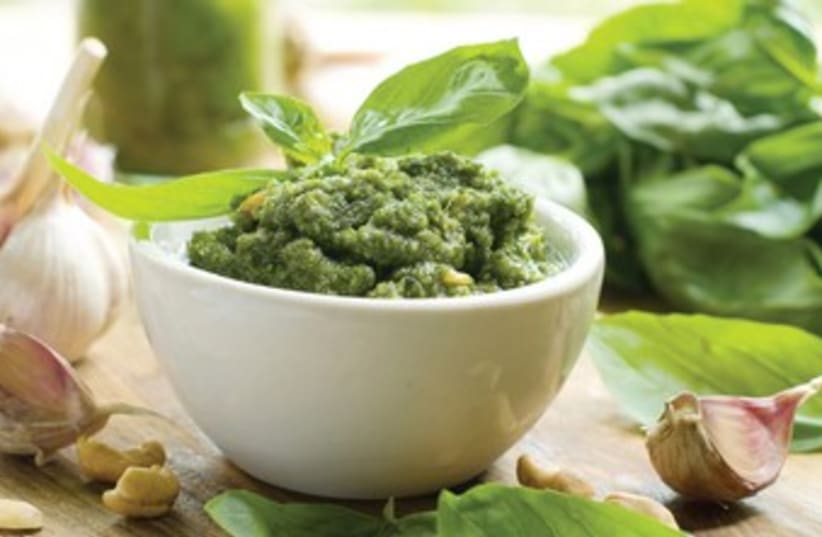ANNA’S SICILIAN PESTO WITH PASTAThis recipe is from The Flavors of Sicily. Author Anna Tasca Lanza writes that no two recipes of the famous Pantescan pesto (from the island of Pantelleria off the coast of Sicily) are alike. She varies the herbs according to what she has on hand. “I just go out into the garden and pick as many herb leaves as I think I’ll need and proceed from there. The pesto tastes better if it sits for a day.Makes 4 servings2 cups (120 gr. or 4 ounces) mixed herbs, such as mint, parsley, basil and sage2 cloves garlic4 small ripe tomatoes (225 gr. or 8 ounces), cut up1 tsp. sugar SaltGround hot pepper1⁄3 cup olive oil450 to 500 gr. (1 pound) spaghetti1⁄4 cup slivered almonds (see Note below)Combine the herbs, garlic and tomatoes in a food processor and process until roughly chopped. Add the sugar and salt and hot pepper to taste. With the machine running, pour in 1⁄4 cup of the oil. Process just until blended. Scrape into a bowl or jar.Pour the remaining oil on top. Refrigerate overnight to let the flavors develop.Just before serving, cook the spaghetti in plenty of boiling salted water until al dente.Drain. Stir the pesto and toss with the pasta.Sprinkle the almonds on top and serve.Note: If the almonds are very flavorful, use them as is; otherwise, toast them lightly to heighten the flavor.CLASSIC PESTOPesto is easy to make in the food processor.If you like, substitute 1⁄2 cup parsley leaves for the basil. To make the pesto parve or vegan, omit the cheese. You can keep the pesto, covered, for 2 days in the refrigerator. Bring it to room temperature for serving.This makes enough for 450 to 500 gr.(1 pound) pasta, to serve 4 to 6.6 medium garlic cloves, peeled1⁄4 cup pine nuts or diced walnuts2 cups (about 55 gr. or 2 ounces packed basil leaves1 cup (about 80 gr. or 3 ounces) freshly grated Parmesan cheese2⁄3 cup fine quality olive oil, preferably extra-virginWith the blade of the food processor turning, drop the garlic cloves, one at a time, through feed tube and process them until finely chopped. Add the pine nuts, basil and cheese and process until basil is chopped.With the blade turning, gradually add the olive oil. Scrape down sides and process until mixture is well blended. Transfer to a small bowl.Refrigerate the pesto if you are making it ahead.Faye Levy is the author of Sensational Pasta.
Popular sauce
Pesto can be used on pasta, sandwiches with goat cheese and roasted vegetables or on broiled or baked fish.

ANNA’S SICILIAN PESTO WITH PASTAThis recipe is from The Flavors of Sicily. Author Anna Tasca Lanza writes that no two recipes of the famous Pantescan pesto (from the island of Pantelleria off the coast of Sicily) are alike. She varies the herbs according to what she has on hand. “I just go out into the garden and pick as many herb leaves as I think I’ll need and proceed from there. The pesto tastes better if it sits for a day.Makes 4 servings2 cups (120 gr. or 4 ounces) mixed herbs, such as mint, parsley, basil and sage2 cloves garlic4 small ripe tomatoes (225 gr. or 8 ounces), cut up1 tsp. sugar SaltGround hot pepper1⁄3 cup olive oil450 to 500 gr. (1 pound) spaghetti1⁄4 cup slivered almonds (see Note below)Combine the herbs, garlic and tomatoes in a food processor and process until roughly chopped. Add the sugar and salt and hot pepper to taste. With the machine running, pour in 1⁄4 cup of the oil. Process just until blended. Scrape into a bowl or jar.Pour the remaining oil on top. Refrigerate overnight to let the flavors develop.Just before serving, cook the spaghetti in plenty of boiling salted water until al dente.Drain. Stir the pesto and toss with the pasta.Sprinkle the almonds on top and serve.Note: If the almonds are very flavorful, use them as is; otherwise, toast them lightly to heighten the flavor.CLASSIC PESTOPesto is easy to make in the food processor.If you like, substitute 1⁄2 cup parsley leaves for the basil. To make the pesto parve or vegan, omit the cheese. You can keep the pesto, covered, for 2 days in the refrigerator. Bring it to room temperature for serving.This makes enough for 450 to 500 gr.(1 pound) pasta, to serve 4 to 6.6 medium garlic cloves, peeled1⁄4 cup pine nuts or diced walnuts2 cups (about 55 gr. or 2 ounces packed basil leaves1 cup (about 80 gr. or 3 ounces) freshly grated Parmesan cheese2⁄3 cup fine quality olive oil, preferably extra-virginWith the blade of the food processor turning, drop the garlic cloves, one at a time, through feed tube and process them until finely chopped. Add the pine nuts, basil and cheese and process until basil is chopped.With the blade turning, gradually add the olive oil. Scrape down sides and process until mixture is well blended. Transfer to a small bowl.Refrigerate the pesto if you are making it ahead.Faye Levy is the author of Sensational Pasta.